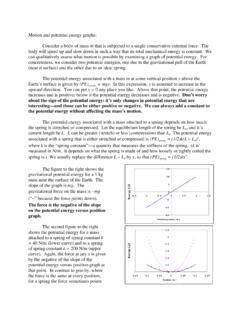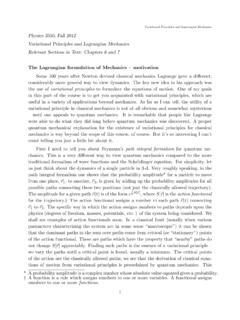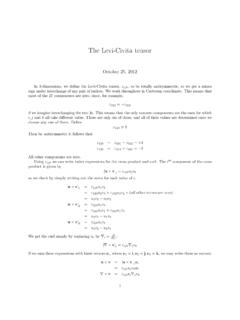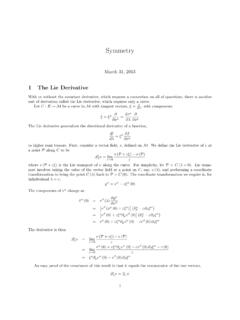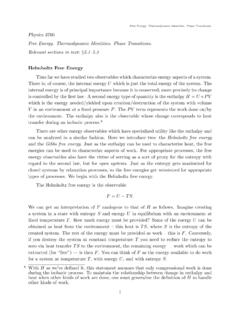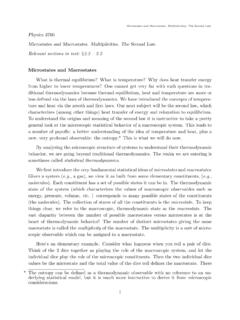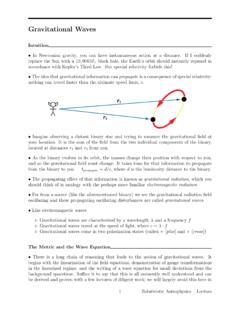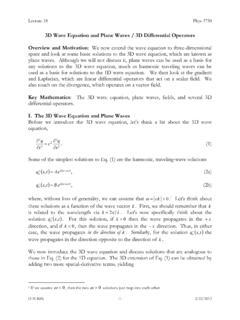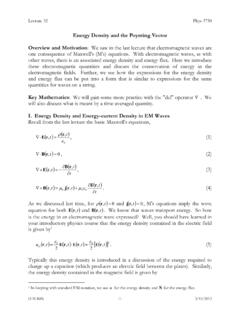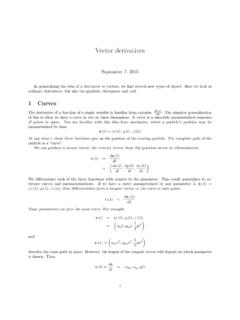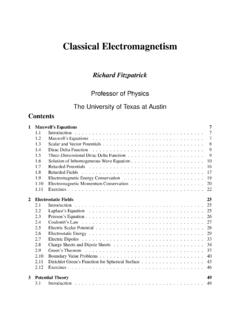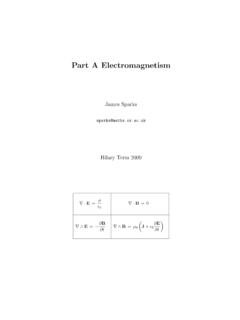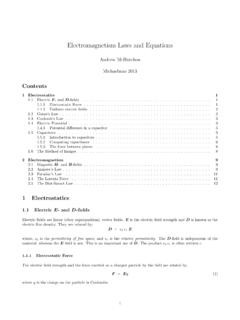Transcription of Electromagnetism: the simplest gauge theory - USU
1 Classical Field TheoryElectromagnetism: the simplest gauge theoryElectromagnetism: the simplest gauge theoryElectromagnetismLet us now study some of the salient field theoretic properties of electromagnetictheory . This is historically the first and also the simplest example of a gauge theory .We shall see that certain structural features familiar from KG theory appear also forelectromagnetic theory and that new structural features appear as begin with a quick review of Maxwell s :Maxwell s equations for the electric and magnetic field (~E,~B) associated tocharge density and current density ( ,~j) are given by ~E= 4 ,(1) ~B= 0,(2) ~B 1c ~E t= 4 ~j,(3) ~E+ ~B t= 0.
2 (4)Show that for any function and vector field~A(~r,t) the electric and magnetic fields definedby~E= 1c ~A t,~B= ~A(5)satisfy the second and fourth Maxwell equations shown :Define the anti-symmetric arrayF in inertial Cartesian coordinatesx =(t,x,y,z), = 0,1,2,3 viaFti= Ei, Fij= ijkBk, i,j= 1,2,3.(6)Under a change of inertial reference frame corresponding to a boost along thexaxis withspeedvthe electric and magnetic fields change (~E,~B) (~E ,~B ), whereEx =Ex, Ey = (Ey vBz), Ez = (Ez+vBy)(7)Bx =Bx, By = (By+vEz), Bz = (Bz vBy).(8)1c C. G. TorreClassical Field TheoryElectromagnetism: the simplest gauge theoryShow that this is equivalent to saying thatF are the components of a tensor of type(02).
3 PROBLEM:Define the 4-currentj = ( ,ji), i= 1,2,3.(9)Show that the Maxwell equations take the formF , = 4 j , F , +F , +F , = 0,(10)where indices are raised and lowered with the usual Minkowski :Show that the scalar and vector potentials, ( ,~A), when assembled into the4-potentialA = ( ,Ai), i= 1,2,3,(11)are related to the electromagnetic tensorF byF = A A .(12)This is the general (local) solution to the homogeneous Maxwell equationsF , +F , +F , = the electromagnetic field can be described solely by the field tensorFin Maxwell sequations, if we wish to use a variational principle to describe this field theory we will haveto use potentials.
4 * So, we will describe electromagnetic theory using the scalar and vectrpotentials, which can be viewed as a spacetime1-formA=A (x)dx .(13)Depending upon your tastes, you can think of this 1-form as (1) a (smooth) section ofthe cotangent bundle of the spacetime manifoldM; (2) tensor field of type(01); (3) aconnection on aU(1) fiber bundle; (4) a collection of 4 functions,A (x) defined in a givencoordinate systemx and such that in any other coordinate systemx A (x ) = x x A (x(x )).(14)* It can be shown using techniques from theinverse problem of the calculus of variationsthat there is no variational principle for Maxwell s equations built solely from (~E,~B) andtheir C.
5 G. TorreClassical Field TheoryElectromagnetism: the simplest gauge theoryIn any case,Ais called the Maxwell field , the electromagnetic field , the electromag-netic potential , the gauge field , the 4-vector potential (!), the U(1) connection , andsome other names as well, along with various mixtures of always, having specified the geometric nature of the field, the field theory is definedby giving a Lagrangian. To define the Lagrangian we introduce thefield strength tensorF,also known as the Faraday tensor or as the curvature of the gauge fieldA. We writeF=F (x)dx dx .(15)The field strength is in fact a two-form (an anti-symmetric(02)tensor field):F = F ,(16)and we can writeF=12F (dx dx dx dx ) =12F dx dx ,The field strength is defined as the exterior derivative of the Maxwell field:F=dA,(17)that is,F =A , A.
6 (18)This guarantees thatdF= 0, which is equivalent to the homogeneous Maxwell equationsF , +F , +F , = 0. Thus the only remaining Maxwell equations to be consideredareF , = 4 j .The 6 independent components ofFin an inertial Cartesian coordinate chart (t,x,y,z)define the electric and magnetic fields as perceived in that reference frame. Note, however,that all of the definitions given above are in fact valid on an arbitrary spacetime manifoldin an arbitrary system of Lagrangian for electromagnetic theory on an arbitrary spacetime (M,g) canbe defined by then-form (wheren=dim(M)),L= 14F F=Ldx1 dx2 dx3 dx4,(19)where Fis the Hodge dual defined by the spacetime metricg.
7 In terms of components ina coordinate chart we have the Lagrangian density given byL= 14 gF F ,(20)whereF =g g F .(21)3c C. G. TorreClassical Field TheoryElectromagnetism: the simplest gauge theoryOf course, we can and usually will restrict attention to the flat spacetime in the standardCartesian coordinates for explicit computations. It is always understood thatFis builtfromAin what us compute the Euler-Lagrange derivative ofL. For simplicity we will work on flatspacetime in inertial Cartesian coordinates so thatM=R4, g=g dx dx = dt dt+dx dx+dy dy+dz dz(22)We have L= 12F F = 12F ( A , A , )= F A , =F , A +D ( F A ).(23)From this identity the Euler-Lagrange expression is given byE (L) =F , ,(24)and thesource-free Maxwell equations areF , = 0.
8 (25)There are some equivalent expressions of the field equations that are worth knowingabout. First of all, we have thatF , = 0 g F , F , = 0,(26)so that the field equations can be expressed asg (A , A , ) = 0.(27)We write this using the wave operator(which acts component-wise on the 1-formA)and the operatordivA=g A , =A , =A , .(28)viaA (divA), = 0.(29)You can see that this is a modified wave more sophisticated expression of the field equations, which is manifestly valid onany spacetime, uses the technology of differential forms. Recall that on a spacetime one4c C. G. TorreClassical Field TheoryElectromagnetism: the simplest gauge theoryhas theHodge dual, which identifies the space ofp-forms with the space ofn mapping is denoted by.
9 (30)IfFis a 2-form, then Fis an (n 2)-form. The field equations are equivalent to thevanishing of a 1-form: d F= 0,(31)wheredis the exterior derivative. This equation is valid on any spacetime (M,g) andis equivalent to the EL equations for the Maxwell Lagrangian as defined above on me show you how this formula works in our flat 4-d spacetime. The componentsof Fare given by F =12 F .(32)The exterior derivative maps the 2-forms Fto a 3-formd Fvia(d F) = 3 [ F ]=32 [ ] F .(33)The Hodge dual maps the 3-formd Fto a 1-form d Fvia( d F) =16 (d F) =14 F = [ ] F =F , .(34)So that d F= 0 F , = 0.
10 (35)The following two problems are easy to do, but they establish some key structuralfeatures of electromagnetic :Show that the EL derivative of the Maxwell Lagrangian satisfies the differ-ential identityD E (L) = 0.(36)PROBLEM:Restrict attention to flat spacetime in Cartesian coordinates, as usual. Fixa vector field on spacetime,j =j (x). Show that the LagrangianLj= 14 gF F +j A (37)5c C. G. TorreClassical Field TheoryElectromagnetism: the simplest gauge theorygives the field equationsF , = j .(38)These are the Maxwell equations with prescribedelectric sourceshaving a charge density and current density~j, wherej = ( ,~j).(39)Use the results from the preceding problem to show that the Maxwell equations withsources have no solution unless the vector field representing the sources is divergence-free: j = 0.
